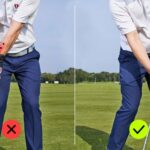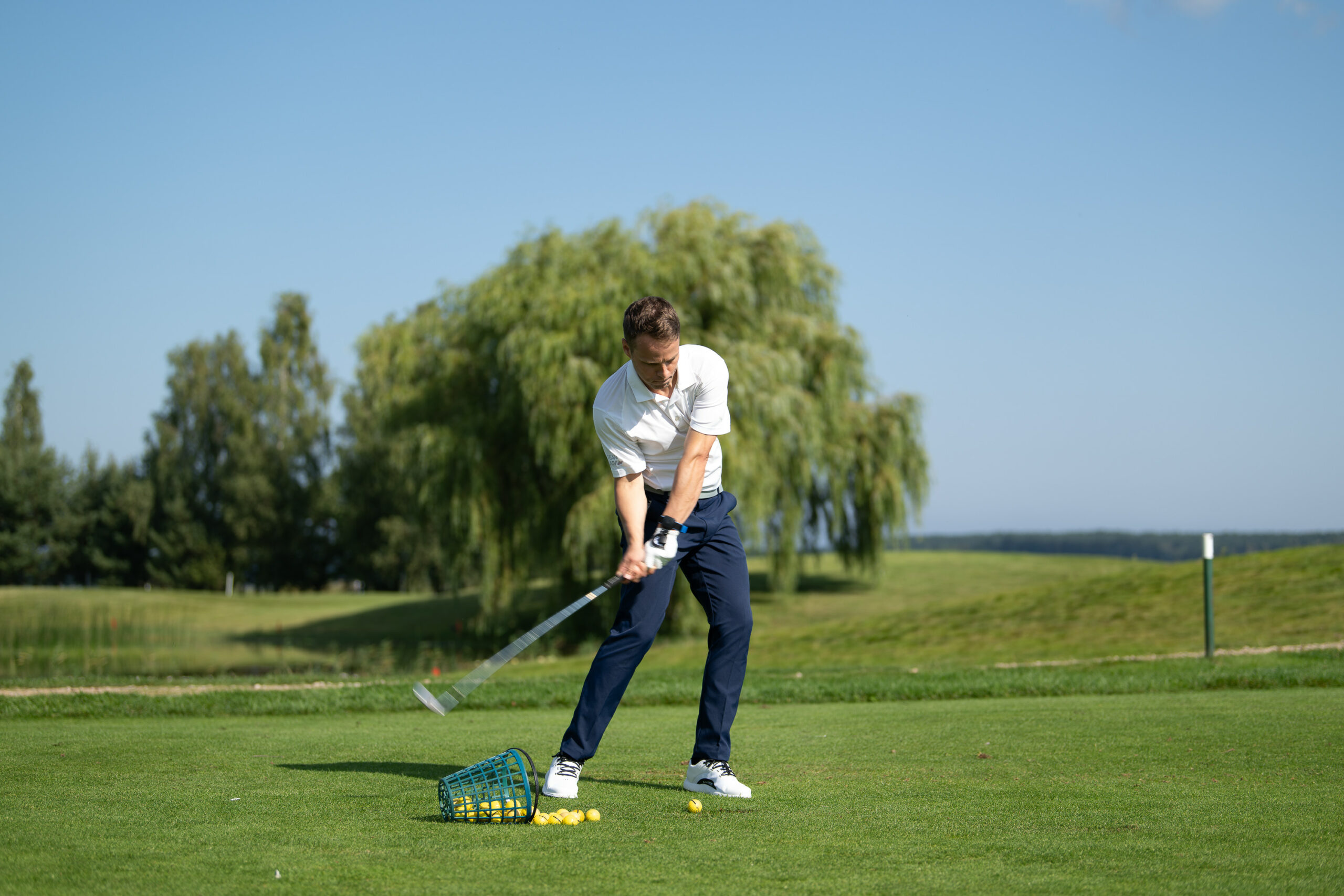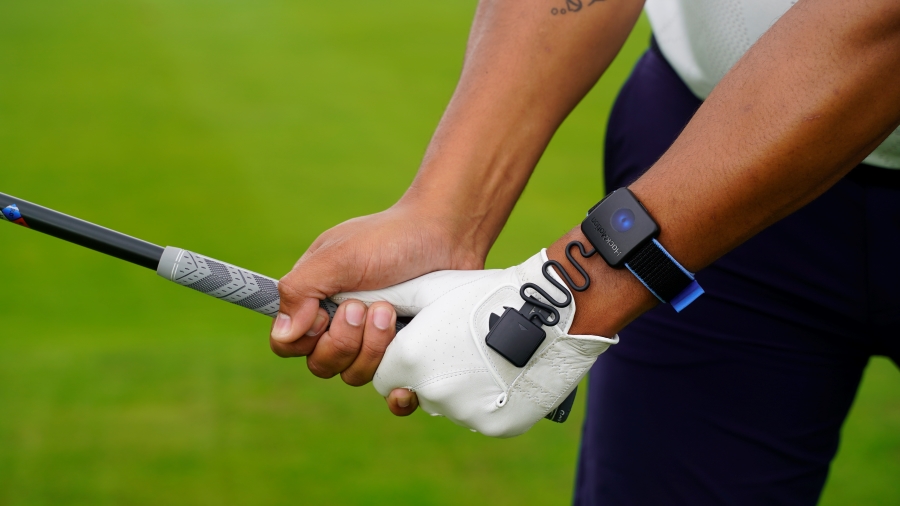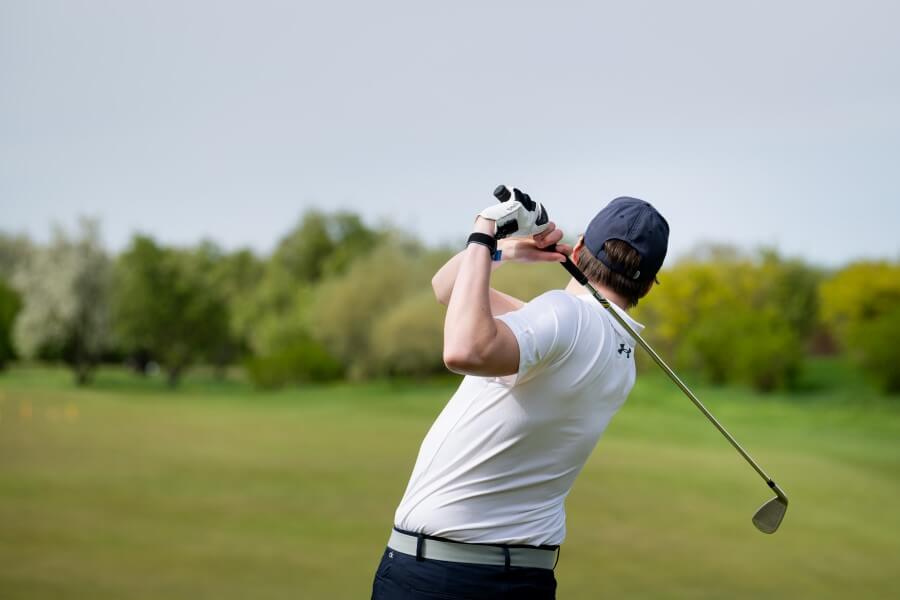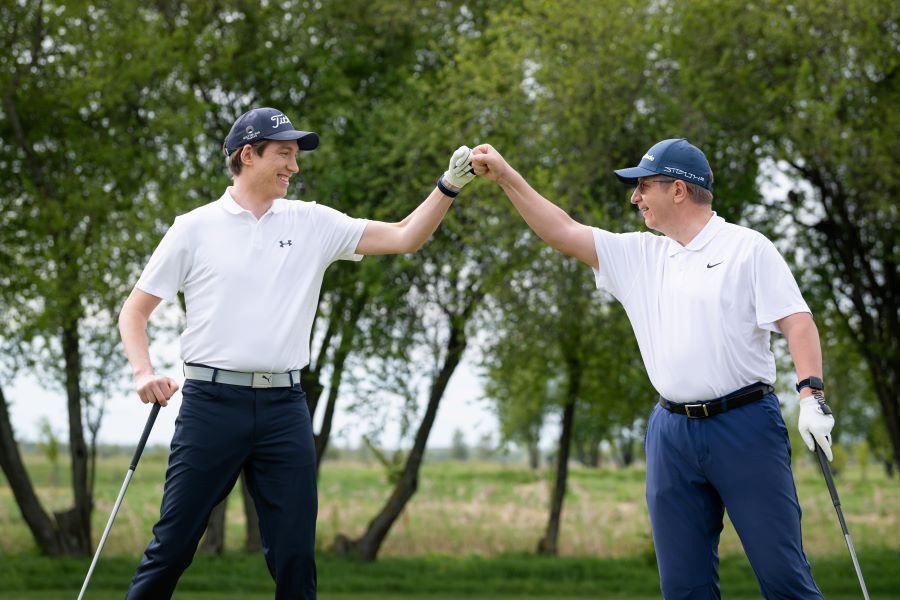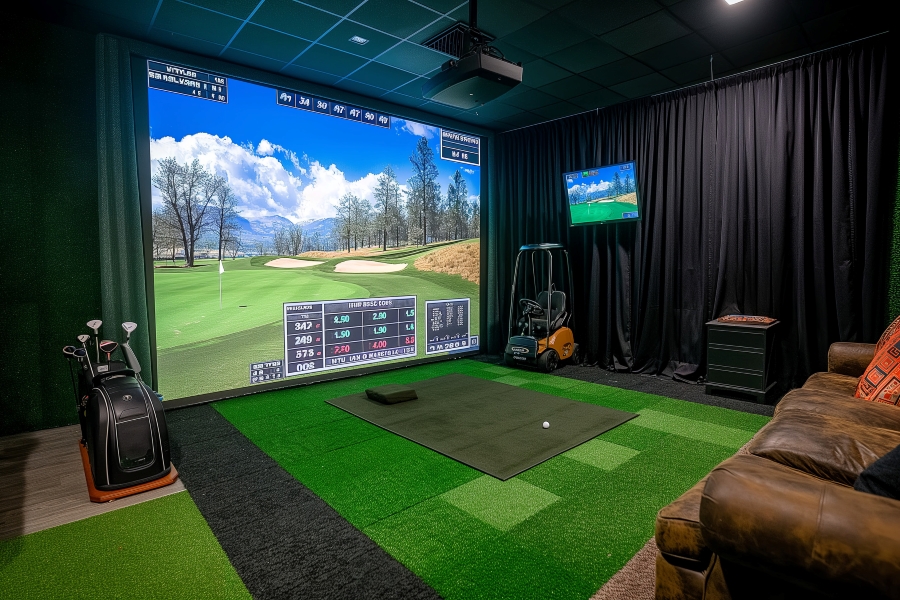How to Hit a Golf Ball Below Your Feet (Setup Adjustments, Swing Tips & Drills)
Navigating the changing terrain of each golf course and even each golf shot is one of the biggest pleasures of golf. If you are prepared for these challenges, the game will remain fun, and your scores won’t be affected.
However, if you’ve never taken the time to study these shots and put in some dedicated practice time, then hitting a shot where the ball is below your feet can be a nightmare and a scorecard killer.
Making minor adjustments to your stance and swing is all it takes to take advantage of a ball below your feet. Once you’ve educated yourself and gotten some hands-on experience, you can confidently add this shot to your repertoire.
Use the guide below to understand the unique nature of this shot and then perform the specific drills to make you a ball-below-your-feet expert.
Ball Below Feet in Golf (Key Takeaways)
Approach shots where the ball is below your feet confidently with these key points that all experienced players already know.
- Adjust your address and posture to get yourself in the correct position to adapt to all slope severities.
- Choose a club and adjust for the changing distance based on the lie.
- Monitor your wrist and forearm movement to control the clubface through impact.
- Understand how the slope will affect the trajectory and ball flight.
- Use cues to prepare for each shot consistently and produce successful results.
Contents
- Why The Ball Below Your Feet Makes Shots Go Right And High
- Golf Ball Below Feet: Setup Changes That Make the Shot Easier
- Distance Control and Club Selection
- Wrist and Forearm Tendencies You Should Control
- Body Movement and Balance Cues When the Ball is Below Your Feet
- Trajectory Management and Shot Planning
- Common Mistakes and Quick Fixes
- Drills to Practice Hitting Shots with the Ball Below Your Feet
- Final Thoughts
Why The Ball Below Your Feet Makes Shots Go Right And High
When the ball is below your feet, you are forced to bend more from the hips and reach farther with your arms. As a result, the plane of your swing becomes steeper, and this leads to an out-to-in (or over-the-top) swing path.
However, because you are unable to fully rotate through the shot due to being off-balance, your clubface can remain open to the target line throughout impact, causing the ball to start or finish right.
The lie itself affects the clubface’s physical orientation. Imagine holding a club normally, with the sole flat on the ground; the face points directly towards your target. But when the ball drops below your feet, the heel of the club makes more contact with the ground.
This situation opens the clubface relative to your intended line, promoting a rightward shot trajectory.
At this angle, it’s also harder to properly compress the ball, and you tend to contact the lower grooves of the clubface. This, in turn, imparts a higher launch angle and increased spin, resulting in shots that fly higher than expected.
If you also struggle with the opposite sidehill lie, check out our guide on how to hit shots when the ball is above your feet so you can handle both slopes confidently.
Golf Ball Below Feet: Setup Changes That Make the Shot Easier
- Widen Your Stance: Adopt a slightly wider stance than normal. This increases stability and balance, helping to prevent you from falling forward during your swing since the slope pulls your weight toward your toes.
- Flex Your Knees More: Bend your knees more deeply than usual. This lowers your center of gravity and helps you reach the ball more comfortably without excessively bending at the waist or hunching over.
- Bend from the Hips: Hinge from your hips to reach down to the ball, keeping your upper body balanced. Avoid rounding your shoulders or collapsing your chest, as that can restrict your swing arc.
- Grip Down on the Club: Choke down on the grip by an inch or more, depending on how far below your feet the ball is. This adjustment gives you greater control over the club and offsets the extra distance to the ball.
- Minimize Wrist Action: Golfers should focus on keeping the wrists soft yet controlled through the downswing to actively help close the clubface at impact, rather than letting it stay open and sending the ball right. Try not to “flip” the wrists or over-rotate them in compensation, as this can produce inconsistent strikes, especially on uneven lies.
- Aim Left of the Target (for Right-Handed Golfers): Since shots from this lie tend to move right, align yourself and your clubface slightly left of your intended target to compensate for the rightward ball flight.
- Stand a Bit Closer to the Ball: The slope naturally increases the distance between your body and the ball, so move a little closer to ensure a centered, efficient strike.
- Make a Smoother, Slower Swing: Focus on making a compact, controlled swing rather than going at full speed. A smoother tempo helps maintain balance and increases your chances of consistent contact.
Distance Control and Club Selection
Optimizing distance control and club selection from a ball-below-feet lie requires a clear understanding of how the slope impacts both contact quality and shot trajectory.
This inconsistency in contact almost always results in a loss of distance.
To compensate for the expected reduction in distance, most golfers opt to take at least one more club than they would from a level lie.
This accounts for both the increased likelihood of off-center contact and the higher, shorter ball flight.
Also, because these lies require a smoother, more controlled swing to maintain balance and accuracy, you are naturally not producing maximum clubhead speed, which further affects distance.
Apart from club selection, managing distance control involves adjustments in swing tempo and expectations around shot trajectory. A smooth, deliberate tempo provides the best probability for solid contact and consistent ball flight, so avoid trying to force the ball or “muscle” it to the target.
When you combine an extra club, a well-paced swing, and a conscious understanding of how the slope impacts golf ball flight, you give yourself the best chance to control distance and achieve a favorable result.
Wrist and Forearm Tendencies You Should Control
When addressing a ball below your feet, the wrists and forearms take on a heightened importance in maintaining both control and accuracy throughout the swing.
The wrists act as the main instrument for squaring the clubface against the tendency to leave it open, which would send the ball right of the target for a right-handed golfer.
The forearms must work in conjunction with the wrists to help square the clubface and maintain the proper swing arc.
They should remain relaxed but engaged, allowing the wrists to actively work toward squaring up the clubhead without falling into the habit of over-rotating or “flipping” through the shot.
To understand wrist mechanics more deeply and how they influence clubface control from any lie, read our full guide on wrist action in the golf swing.
Using Hackmotion helps track the relationship between your arms and wrists.
The advanced sensors monitor every subtle movement, and the app will alert you when you’ve strayed from optimal movements.
If the wrists and forearms are too rigid, there is a greater chance of hitting a weak, glancing blow, resulting in a loss of power and control. If they are too loose, consistency and accuracy also suffer.
Body Movement and Balance Cues When the Ball is Below Your Feet
| Cue | What to Do | Why It Helps |
|---|---|---|
| Stance | Make it wider for more support | Prevents losing balance on severe slopes |
| Knee Flex | Bend knees more, “sit” into stance | Helps reach the lower ball |
| Weight Distribution | Stay on the balls of your feet, stay centered | More control prevents falling back or forward |
| Posture | Maintain spine tilt, hips back, straight back | Encourages consistent strike, reduces mishits |
| Swing Tempo | Smooth, controlled swing; don’t overswing | Maintains balance, solid ball contact |
| Aim | Aim left of your target | The ball will likely fade (for righties) |
Trajectory Management and Shot Planning
Use these steps to prepare the same way for all shots where the ball is below your feet.
This is a great way to evaluate the situation and prepare your body and your swing to create consistent ball striking and better estimates of how the ball will react.
1. Read the Lie and Slope
Assess how steep the slope is; the steeper it is, the more pronounced the effects. Check whether the ball is sitting up or down in the grass to gauge how the club will strike it.
The thicker the rough, the shorter the distance, but also less spin and less effect the slope will have.
2. Aim Adjustment
Be sure to compensate for a fade. Aim left (for righties) of your intended target by a few yards or even more, depending on the severity of the slope.
Picture the ball’s expected flight path, including the fade, so that you can visualize your landing area and missing side.
3. Club Selection
In most cases, you can take one extra club to counteract the lower trajectory and possible reduced distance of a mishit from this awkward stance.
Don’t try to “full send” the ball from an uneven lie; your main goal is solid contact and keeping the ball in play.
4. Account for Distance
The awkward stance, likely off-center contact, and lower flight mean your shot may not go as far as it would from flat ground.
Focus on a safe target and aim for the wider part of the green or fairway, or away from hazards, since shot shape is less predictable.
5. Club Grip and Swing Path
Choke down on the club to enhance control and make it easier to make solid contact with the ball on a lower plane.
Aggressive swings from this stance almost always lead to mishits or poor balance.
Common Mistakes and Quick Fixes
- Standing too narrow, with your feet too close together, leads to a loss of balance during the swing. Take a slightly wider stance to enhance stability.
- Not adding enough knee flex keeps you too upright and causes topped or thin shots. Always bend your knees a bit more than usual to get down to the ball’s level.
- Leaning too far back or excessively toward the ball risks a fall and inconsistent contact. Before each shot, distribute your weight evenly, based on the severity of the slope, while staying balanced through your feet, not just on your toes.
- Overswinging and losing balance and control. To fix this, always use a controlled, three-quarter swing for consistency and better balance.
- Ignoring Shot Shape and trying to aim directly at the target, not accounting for the fade. Always favor the left to allow for a natural left-to-right ball flight.
Drills to Practice Hitting Shots with the Ball Below Your Feet
Here are a few specific drills that will help you adapt to shots where the ball is below your feet.
You will need to find a slope to get the most out of your practice sessions, but most ranges have space at the far end of the tee deck.
Hit Hard, Stop Quick Drill
Gaining control over your tempo is vital to creating a smooth swing that will consistently produce.
This drill helps with tempo while also keeping your mechanics in check. Use this drill with HackMotion for maximum results.
- Video Timestamp: 3:01 – 8:21
Hit Hard, Stop Quick Drill – Step by Step:
- Address a ball on a side slope where the ball is below your feet.
- Take a half or three-quarter backswing, then do your downswing at normal speed or even a bit faster than usual.
- After you strike the ball, stop your follow-through as quickly as possible. This should be before the club shaft reaches parallel to the ground.
- Once you’ve stopped, check your wrist positions and balance to ensure everything is being done correctly.
Ruler Wrist Drill
This drill will help you keep the clubface square and reduce the fading effect that most shots where the ball is below your feet create.
It provides a physical barrier that trains your muscles to react positively to the slope and helps you hit straighter and more controlled irons from any lie.
- Video Timestamp: 6:06 – 8:55
Ruler Wrist Drill – Step by Step:
- Insert a plastic ruler into your lead hand glove so 70% of the ruler is outside the glove and running up your arm, over the back of your wrist.
- Start with small swings, or even pitch shots, to get acclimated to the feeling.
- Never take full swings with this drill, but you can escalate to half swings while focusing on keeping your lead wrist flat through impact.
Death Drill (Short Game)
Chipping from a sidehill lie brings its own challenges. It’s delicate, and although the distance is much shorter than a full shot, a lot can still go wrong.
Use this drill to gain confidence with your chipping while the ball is below your feet.
- Video Timestamp: 6:30 – 8:53
Death Drill – Step by Step:
- Place an alignment stick under your trailing arm and secure it between your middle and index finger of your trailing hand.
- Grasp your wedge and find a comfortable position for your hands. This may feel uncomfortable, and that’s ok. The point of the drill is to control your arms and body rotation.
- Only use this drill for short chips where your club never goes past parallel on the backswing or follow-through.
Final Thoughts
With the proper setup, club selection, and tempo, there is no reason to fear a shot where the ball is below your feet.
Even the most severe slopes can be handled with ease as long as you’ve put the practice in and approach each shot with care.
Using the HackMotion system during your practice sessions will speed up your learning and ensure your mechanics and tempo are solid across all types of sidehill lies. The sensors monitor minor movements and alert you when there is room for improvement.
Use HackMotion for all aspects of your golf game, not just when the ball is below your feet. It’s like having a professional golf coach at your side at all times.





